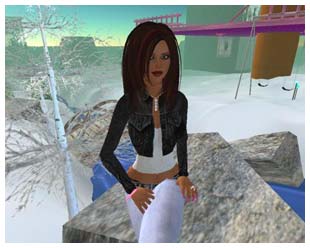
As mentioned in a prior post, I’ve been spending some time exploring Second Life’s virtual world. One expects that objects, graphics, animations, physics and the rest improve in this corner of cyberspace just like they do most everywhere else. That’s just technology, and videogames have certainly been showing off some amazing things lately. But what I’m finding interesting is how real people interact with – and through – this virtual world.
Take for example the above image, “sittin’ at the crick…”. For lack of a better description, this is a “photograph” snapped by an SL “resident”, Jellybean Madison. She (apparently) posted it online from within the SL simulation using a third party tool called Snapzilla. I’ll let them explain it:
Snapzilla [is a] new feature from SLUniverse that allows everyone in Second Life to share their snapshots with the world, directly through SL. Downloading snapshots to your hard drive and then uploading them is hardly spontaneous. With Snapzilla, you just click the Snapshot button in Second Life and choose Email Postcard and you are on your way to sharing your snapshots.
An image posted and given a caption? Emailed to others? Shared? Why? I don’t know exactly because I’m too new to the experience. But I have noticed that there are other, similar tools in beta which send images to sites like Flickr, possibly the best known and most popular image-hosting website on the net. So these snapshots will be seen by a large audience; many of whom have never been inside a virtual reality sim. Furthermore, in as much as all images online are really nothing more than colored pixels, these “photos” are as real to the strangers who view them as the “real” photos taken in meatspace using a 35mm. And when the graphics improve in years to come, who’s to say what’s valid and what isn’t?
But it doesn’t stop with photos. I was checking my email yesterday and discovered that an “in-world” message had been forwarded to my real world email. Lines blur. It’s one thing to know of this interactivity and another to experience it. And even more interesting are the number of independent projects coded by residents for doing things like tracking virtual world assets (which have real world value in many cases) outside the simulation. Now that sounds like the kind of thing Microsoft should build into their Xbox 2 feature set.

